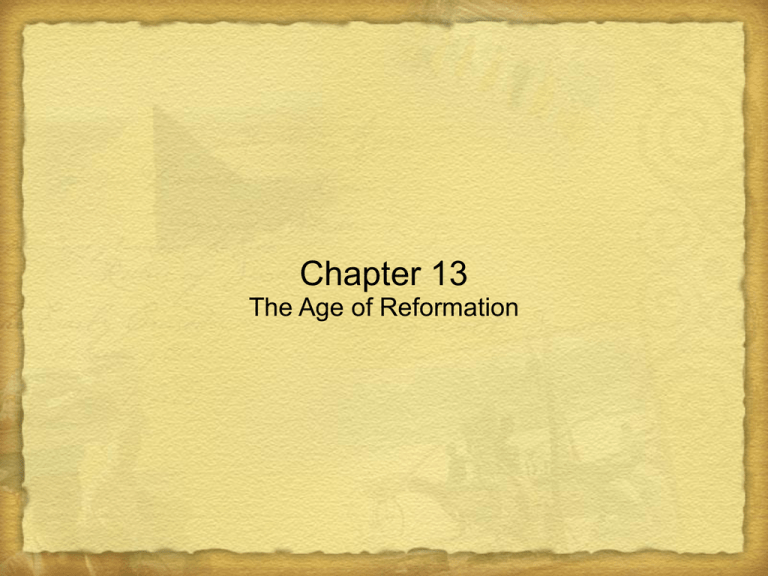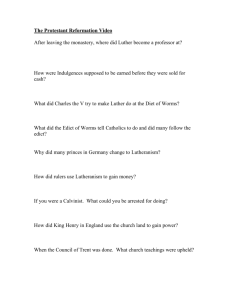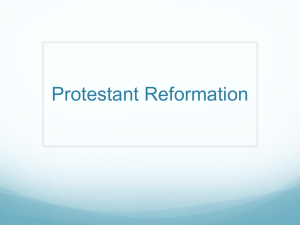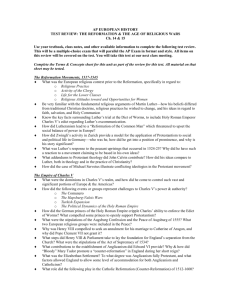Prelude to Reformation: The Northern Renaissance
advertisement

Chapter 13 The Age of Reformation Prelude to Reformation: The Northern Renaissance Christian or Northern Renaissance Humanism Sources of Christianity Simplicity of Christianity Reform of religion Reform of education Desiderius Erasmus (1466-1536) Handbook of the Christian Knight, 1503 In Praise of Folly, 1511 Thomas More (1478-1535) Utopia, 1516 Henry VIII Prelude to Reformation: Church and Religion on the Eve of Reformation The Clergy Wealth Ignorance Division between higher and lower clergy Popular Religion Relics Thomas à Kempis (1380-1471) The Imitation of Christ Deemphasis of religious dogma Indulgences Martin Luther and the Reformation of German Early Luther From peasantry Study of law Monastic life University of Wittenberg “Justice of God” “Justification by faith” Archbishop Albrecht Johann Tetzel Indulgences 95 Theses on Wittenberg Church door, 1517 Debate at Leipzig, July 1519 Address to the Nobility of the German Nations, 1520 The Babylonian Captivity of the Church, 1520 Excommunicated , 1521 Diet of Worms, 1521, Trial Development of Lutheranism Appeal to university students Urban phenomenon Older generation of humanists break from Lutheranism Philip Melanchthon (1497-1560) Peasants’ War, mid-1520s Against the Robbing and Murdering Hordes of Peasants The Empire of Charles V 1. The empire of Charles V, Holy Roman Emperor (1519-1556), was a consequence of diverse inheritances. From his mother, Juanna, the daughter of Ferdinand and Isabella, he gained the now unified crown of Spain (Castile and Aragon), the Spanish New World possessions, and lands in Italy (Sicily, Sardinia, and the Kingdom of Naples). From his grandfather Maximilien of Austria (1493-1519), Charles obtained Austria, Tyrol, Milan, and territories in southern Germany. Charles' grandmother, Mary of Burgundy, left him the Netherlands (Low Countries) and Franche-Comte. 2. With a massive campaign chest, the nineteen year old Charles successfully won election by the seven German electors as Holy Roman Emperor in 1519 though he was opposed by Pope Leo X (1513-1521) who supported French king Francis I (1515-1547). 3. The lands of Charles were a source of constant trouble. As Holy Roman Emperor he faced the challenge of Lutheranism. As the ruler of Naples and Sicily, he was in a constant war with the ambitious French king Francis I. In Austria, Charles was faced with the aggression of Turks who were at the walls of Vienna in 1529. In Spain, after being crowned king in 1516 Charles was faced with a revolt in 1520 when he left behind a Flemish regent during his absence in Germany. 4. The rebellion in Spain began in Toledo and very quickly other cities joined it to protest the delegation of political authority to foreigners. There also existed a feeling that Charles was abusing the traditional rights and privileges of both the nobility and the towns. Ultimately, fifteen cities formed a league of opposition bringing together the nobility, clergy, and the people in what was called the Revolt of the Comuneros. Charles prudently appointed two Castilian nobles as co-regents. 4. It is worth noting that the territories of the Habsburgs came to encircle France which now feared for its security. Further causing consternation was the consolidation of the Germanies to the east by the Habsburgs. 4. So unwieldy was the empire of Charles that in 1521-22 he transferred eastern Austrian territory and parts of the German territory to his brother Ferdinand. In 1556 when Charles abdicated in retirement, Ferdinand I (1556-1564) took the mantle of Holy Roman Emperor. Questions: 1. For Charles, what were the consequences of holding so many lands under his authority? 2. Why would Francis I of France be a natural enemy of the Habsburgs? The Empire of Charles V Church and State Luther keeps only 2 of 7 Catholic sacraments – baptism and Lord’s supper Bible the authority for religious affairs State dominated churches Germany and the Reformation: Religion and Politics Emperor Charles V, 1519-1556 Holy Roman Empire, Spain, Spanish America Preserve the unity of the Catholic Church Francis I, 1515-1547 Habsburg-Valois Wars, 1521-1544 Suleiman the Magnificent, 1520-1566 Battle of Mohács, 1526 Diet of Augsburg, 1530 Schmalkaldic League Wars against the Turks Schmalkaldic Wars, 1546-1547 Battle of Mühlberg Peace of Augsburg, 1555 Lutherans same legal rights as Catholicism Right of each German rule to determine the religion of his subjects The Spread of the Protestant Revolution Lutheranism in Scandinavia Gustavus Vasa, 1523-1560, of Sweden Frederick I, 1523-1533, of Denmark The Zwinglian Reformation Ulrich Zwingli (1484-1531) Zurich, Switzerland League of evangelical cities Marburg Colloquy, 1529 War between Swiss Protestant and Catholic cantons The Radical Reformation: The Anabaptists Church as a body of believers Democracy Ministers Lord’s Supper as remembrance Refuse to hold political office or bear arms “Thou shall not kill.” Münster, 1530s Menno Simon (1496-1561) Separation from the world The Reformation in England Henry VIII, 1509-1547 Catherine of Aragon Mary I, Need for a divorce Archbishop Thomas Cranmer Second wife, Anne Boleyn Elizabeth I Act of Supremacy and Treason Act, 1534 Six Articles Act, 1539 Third wife, Jane Seymour Edward VI Edward VI, 1547-1553 Movement closer to Protestantism Book of Common Prayer Mary, 1553-1558 Attempted restoration of Catholicism John Calvin and the Development of Calvinism John Calvin (1509-1564) Institutes of the Christian Religion, 1536 “Power, grace, and glory of God” Predestination Two sacraments – baptism and Lord’s Supper Geneva Ecclesiastical Ordinances, 1541 Consistory The Social Impact of the Protestant Reformation The Family Positive view of family relationships Place of women Education in the Reformation German gymnasium Genevan Academy Jesuits as educators Religious Practices and Popular Culture Decline of superstition Reform of social practices Puritans Catholics and Protestants in Europe by 1560 1. Wittenberg was the home to Martin Luther where he taught at the local university. In 1517 Luther posted on the door of the local church ninetyfive theses against the sale of indulgences. Luther presented his views in 1521 to the imperial diet at Worms called by Emperor Charles V (15191556). Refusing to recant his criticism or beliefs, Luther was placed under imperial ban. 2. One of the chief tools for diffusing the ideas of Luther were the students who attended the University of Wittenberg. Between 1520 and 1560 some 16,000 students were graduated. As they returned to their homes throughout Germany they spread the ideas of Luther. 3. In the 1520s as the Union of Kalmar collapsed, Lutheranism appeared in Sweden, Denmark, and Norwary. 4. The teachings of the Anabaptists spread into southern Germany, Austria, and Switzerland. Seen by both Catholics and Lutherans as a threat, the Anabaptists were virtually stamped out in Germany. Some of the survivors went to Munster and proclaimed it the New Jerusalem. As they became radical millenarianist, Lutherans and Catholics increasingly became distrustful and a coalition recaptured the city in 1535. Not only were the Anabaptists exterminated here but also tens of thousands were killed in Germany and the Low Countries. 5. In 1519 Ulrich Zwingli was named the people's priest by the Zürich city council. From this post he was able to guide religious reform in the city. Zwingli saw no distinction between government of the Chruch and the state. Both should be guided by the laws of God. Efforts by Zürich to export to the rest of Switzerland its reform resulted in its spread including to Bern in 1528 and Basel in 1529. Resistance by the Catholics resulted in civil war between the cantons in 1531. That same year the Zürich army was defeated and Zwingli killed. 6. In England the Reformation was political in nature as the Anglican Church was created for the purpose of Henry VIII (1509-1547) giving himself a divorce from Catherine of Aragon. Henry became the head of the church but made few doctrinal changes. Under Henry's sickly son Edward VI (1547-1553) the church drifted to Protestantism. Edward's successor, Mary (1553-1558), tried to move back to Catholicism and persecuted the Protestants. Mary was followed by Elizabeth I (1598-1603) who chose a middle course between Catholicism and Protestantism. 7. John Calvin converted to Protestantism in 1533. By 1536 he was in Geneva and would influence that city until his death in 1564. The central location of Geneva allowed easy dissemination of Calvinism. In southern and western France, Calvinism was received by the Huguenots and it penetrated England as persecuted Protestants returned after the death of Mary. In Scotland John Knox established it. By the 1550s Calvinism had eclipsed Lutheranism among the Polish, Hungarian, and Bohemian nobility thereby facilitating its growth. 8. The Council of Trent, convened by the Church, met from 1545 to 1563 but failed to reconcile Protestant and Catholic differences. Questions: 1. Why did Protestantism grow so rapidly in the sixteenth century? 2. How was the growth of Protestantism in England different from that of the rest of Europe? Catholics and Protestants in Europe in 1560 The Catholic Reformation New mysticism Saint Teresa of Avila, (1515-1582) Religious orders Capuchins Theatines Ursulines Oratory of Divine Love Society of Jesus, 1540 Ignatius of Loyola (1491-1556) The Spiritual Exercises Absolute obedience Francis Xavier (1506-1552) Revived Papacy Pope Paul III, 1534-1549 Reform commission Recognized the Jesuits Council of Trent Pope Paul IV, 1555-1559 Inquisition Council of Trent, 1545-1563 Doctrinal issues Division between moderates and conservatives Reaffirmed traditional Catholic teachings Theological seminaries





